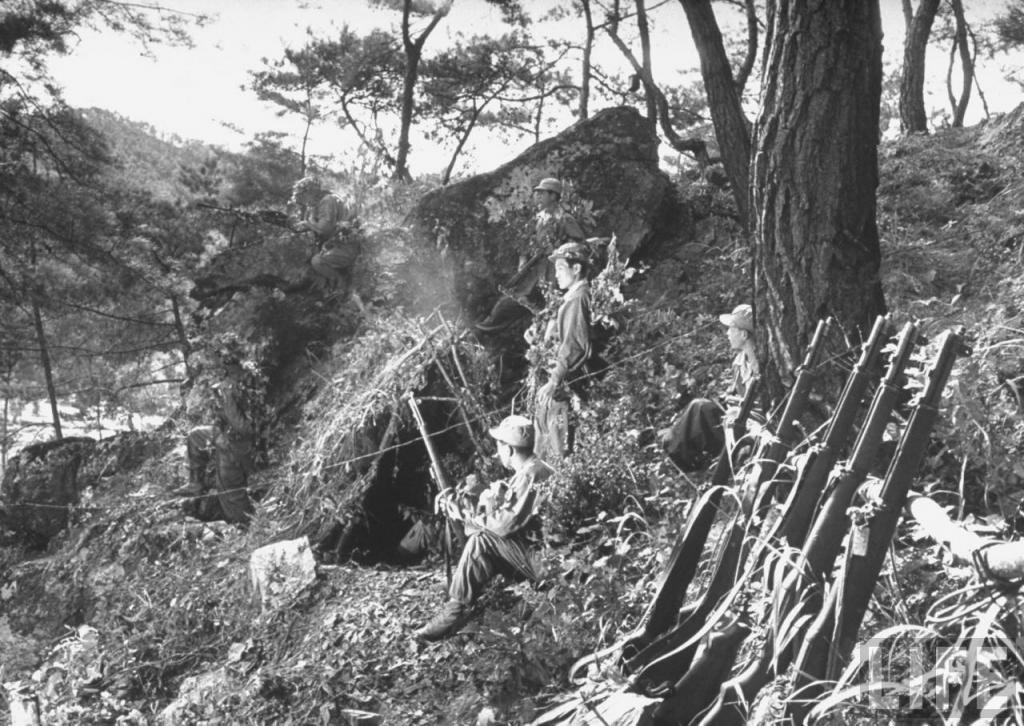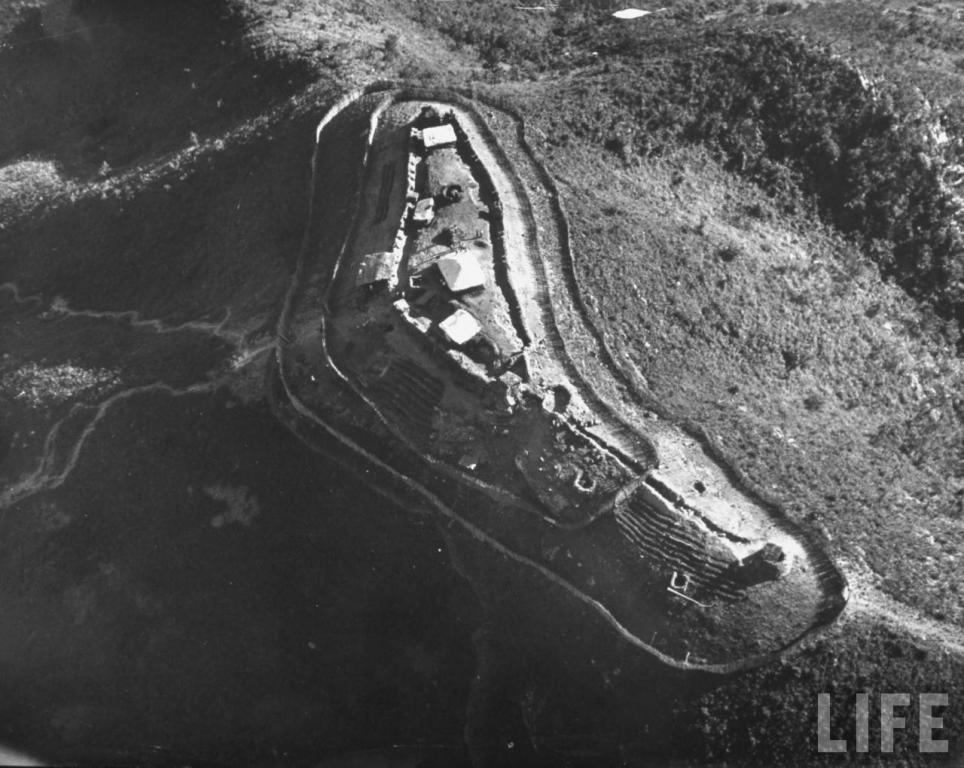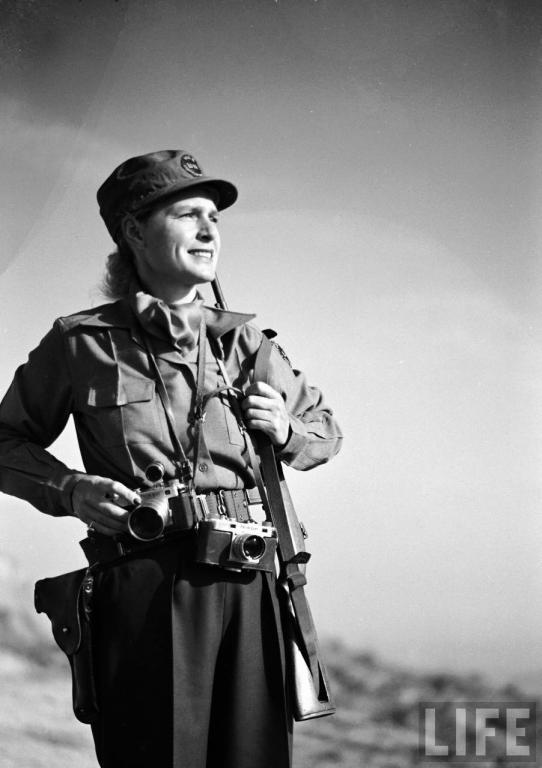-
Contributing Member


12-198 Garand Picture of the Day - Korea
 Operation Area In Korea
Operation Area In Korea
Armed National Police on guard outside tent-shaped grass-covered dugout w. rifles stacked nearby at Communist guerrilla hidout which they took over after capturing 27 of the enemy.

Operation Area In Korea
Aerial view of pollice box North of Youngam fr. which Provincial chief of Korean National Police Han Kyon Lok directs his men in Communist guerrilla search & destroy missions where they are hiding in the hills..
Location:Cholla Poktuk, Korea (South)
Date taken:November 1952
Photographer:Margaret Bourke-White
Location:Cholla Poktuk, Korea (South)
Date taken:November 1952
Photographer:Margaret Bourke-White

Operation Area In Korea
Three ex-Communist guerrillas wearing North Korean Star on their caps, after being repatriated to the forces of Han Kyon Lok, Provincial chief of National Police & are now rounding up unsuspecting Communist guerrillas in the hills around this farmland.
Location:Cholla Poktuk, Korea (South)
Date taken:November 1952
Photographer:Margaret Bourke-White

LIFE photographer Margaret Bourke-White on assignment during the Korean War.
Date taken:1951
Bourke-White was the first female war correspondent and the first woman to be allowed to work in combat zones during World War II. In 1941, she traveled to the Soviet Union just as Germany
Union just as Germany broke its pact of non-aggression. She was the only foreign photographer in Moscow when German forces invaded. Taking refuge in the U.S. Embassy, she then captured the ensuing firestorms on camera.
broke its pact of non-aggression. She was the only foreign photographer in Moscow when German forces invaded. Taking refuge in the U.S. Embassy, she then captured the ensuing firestorms on camera.
As the war progressed, she was attached to the U.S. Army Air Force in North Africa, then to the U.S. Army in Italy and later Germany. She repeatedly came under fire in Italy in areas of fierce fighting.
and later Germany. She repeatedly came under fire in Italy in areas of fierce fighting.
"The woman who had been torpedoed in the Mediterranean, strafed by the Luftwaffe, stranded on an Arctic island, bombarded in Moscow, and pulled out of the Chesapeake when her chopper crashed, was known to the Life staff as 'Maggie the Indestructible.'"[4] This incident in the Mediterranean refers to the sinking of the England -Africa bound British troopship SS Strathallan which she recorded in an article "Women in Lifeboats", in Life, February 22, 1943.
-Africa bound British troopship SS Strathallan which she recorded in an article "Women in Lifeboats", in Life, February 22, 1943.
In the spring of 1945, she traveled through a collapsing Germany with Gen. George S. Patton. She arrived at Buchenwald, the notorious concentration camp, and later said, "Using a camera was almost a relief. It interposed a slight barrier between myself and the horror in front of me." After the war, she produced a book titled Dear Fatherland, Rest Quietly, a project that helped her come to grips with the brutality she had witnessed during and after the war.
"To many who got in the way of a Bourke-White photograph — and that included not just bureaucrats and functionaries but professional colleagues like assistants, reporters, and other photographers — she was regarded as imperious, calculating, and insensitive."
Information
 |
Warning: This is a relatively older thread
This discussion is older than 360 days. Some information contained in it may no longer be current. |
|
Last edited by Mark in Rochester; 07-14-2012 at 01:19 PM.
He is no fool who gives what he cannot keep to gain that which he cannot lose
There are no great men, only great challenges that ordinary men are forced by circumstances to meet.
-
The Following 9 Members Say Thank You to Mark in Rochester For This Useful Post:
-
07-14-2012 12:55 PM
# ADS
Friends and Sponsors

-
Senior Moderator
(Milsurp Forums)


With a carbine and 1911! Very cool! My kind of girl 
Bill Hollinger
"We're surrounded, that simplifies our problem!"
-
-
Contributing Member


yea that is what I was thinking :-)
He is no fool who gives what he cannot keep to gain that which he cannot lose
There are no great men, only great challenges that ordinary men are forced by circumstances to meet.
-
Operation Area In Korea
Union just as Germany
broke its pact of non-aggression. She was the only foreign photographer in Moscow when German forces invaded. Taking refuge in the U.S. Embassy, she then captured the ensuing firestorms on camera.
and later Germany. She repeatedly came under fire in Italy in areas of fierce fighting.
-Africa bound British troopship SS Strathallan which she recorded in an article "Women in Lifeboats", in Life, February 22, 1943.



















 PM
PM








